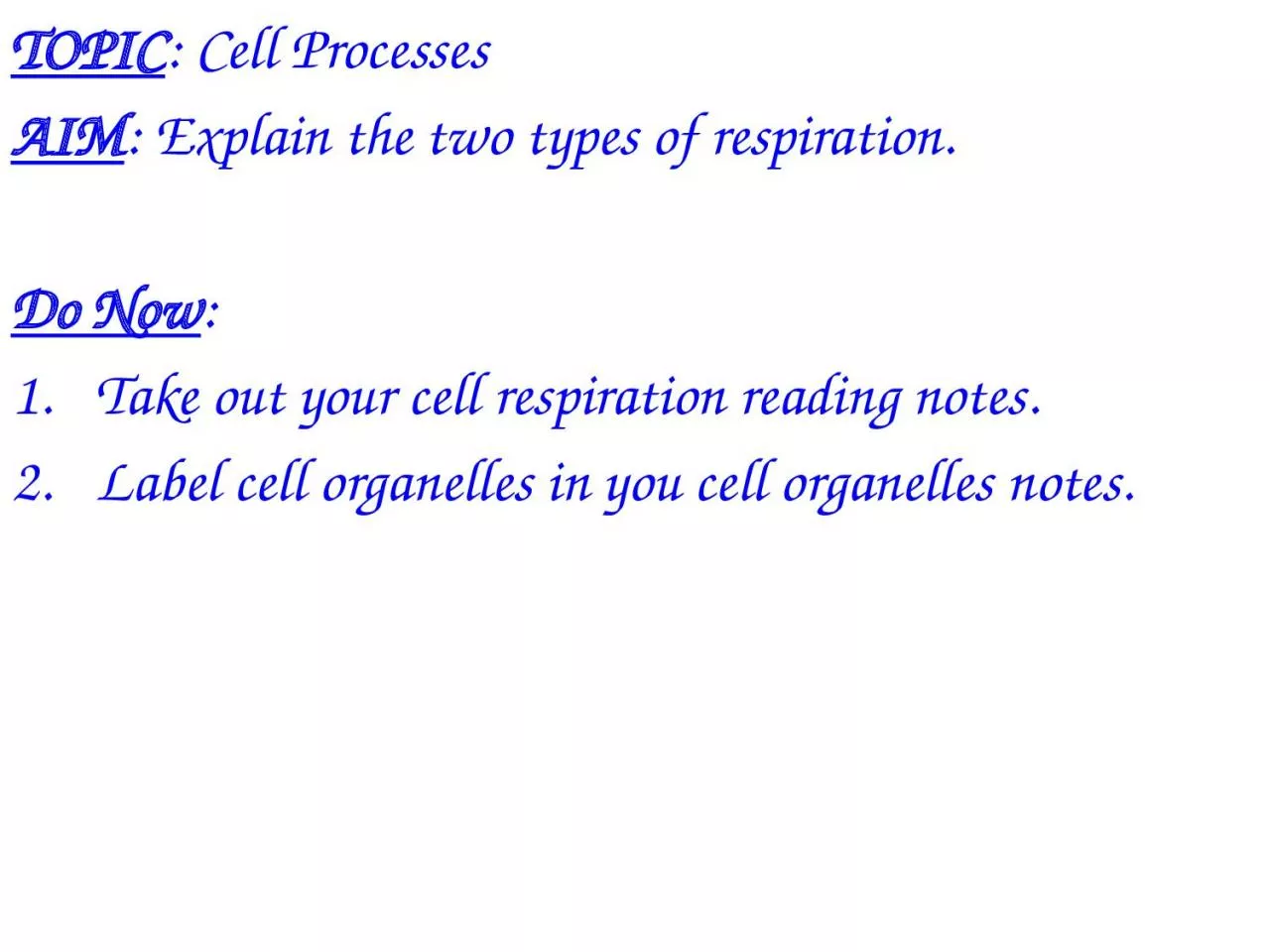

Explain the two types of respiration Do Now Take out your cell respiration reading notes Label cell organelles in you cell organelles notes ER 1 Describe the process of cell respiration ID: 929264
Download Presentation The PPT/PDF document "TOPIC : Cell Processes AIM" is the property of its rightful owner. Permission is granted to download and print the materials on this web site for personal, non-commercial use only, and to display it on your personal computer provided you do not modify the materials and that you retain all copyright notices contained in the materials. By downloading content from our website, you accept the terms of this agreement.
Slide1
TOPIC
: Cell Processes
AIM
: Explain the two types of respiration
.
Do Now
:
Take out your cell respiration reading notes.
Label cell organelles in you cell organelles notes.
Slide2ER
Slide31. Describe the process of cell respiration.
.
Slide42. Identify the two types of cellular respiration.
Slide53. Where does aerobic respiration occur in a cell?
Slide6C
6
H12O
6 + 6O2
6CO2 + 6H2O +
36ATP
Waste Products
EQUATION
Raw materials
Product
Glucose
Oxygen
Carbon dioxide
Water
Energy
Slide74. Identify the raw materials used by aerobic respiration.
Slide85. Identify the waste products released by aerobic respiration.
Slide96. Identify the number of ATP produced as a result of aerobic respiration.
Slide107. Identify the major difference between aerobic and anaerobic respiration.
Slide118. Identify another name for anaerobic respiration.
Slide129. Where does fermentation occur in a cell?
Slide1310. Identify the 2 types of fermentation.
Slide1411. Identify the raw materials of fermentation.
Slide15C
6
H12O
6
Lactic acid + 2ATPEQUATION
Waste Product
Glucose
Energy
Raw material
Slide1612. Identify the
waste product
released as a result of lactic acid fermentation.
Slide1713. Identify the number of ATP produced as a result of lactic acid fermentation.
Slide1814. Identify the types of cells that lactic fermentation occurs.
Slide1915. Describe the effect of lactic acid fermentation in humans.
Slide20C
6
H
12
O6 lactic acid +
2ATPhttp://www.youtube.com/watch?v=DGq94gpKEbg
Slide2116. Identify substances that can be produced by lactic acid fermentation in bacteria.
Slide2217. Identify the organism in which alcoholic fermentation occurs.
Slide23C
6
H12O
6 Ethyl
Alcohol + CO2 + 2ATP
EQUATIONWaste Products
Glucose
Energy
Raw material
Carbon dioxide
Slide2418. Identify substances that can be produced as a result of alcoholic fermentation.
Slide2519. Identify the number of ATP produced as a result of alcoholic fermentation.
Slide26Let
’
s review: Choose AEROBIC or ANAEROBIC or BOTH for the statements below.
Produces 2ATP.
Utilizes oxygen.Can occur in muscle cells when oxygen is not present.
Release lactic acid as waste.Produces 36 ATP.Occurs in mitochondria.
Also known as fermentation.
Release CO
2
and H
2
O as wastes.
Can cause muscle fatigue.
Slide2710. Occurs only in the cytoplasm.
11. Glucose is a raw material.
12. Can release alcohol as a waste.
13. Most efficient.
14. Can occur in yeast.15. Can occur in bacteria.
16. Does not use oxygen.17. Release energy used for all life processes.
Slide28C
6
H12O
6 + 6O2
6CO2 + 6H2O +
ATPGlucoseOxygen
Carbon dioxide
Water
Energy
Identify the equation above. Support your answer.
Identify the location of this process within a cell.
Identify the raw materials of this process.
Identify the WASTE PRODUCTS of this process.
Identify the product used to carry on life activities.
How many ATP are produced?
Slide29C
6
H
12
O6 lactic acid
+ ATP
Identify the equation above. Support your answer.
Identify the location of this process within a cell.
Identify the raw materials of this process.
Identify the WASTE PRODUCTS of this process.
Identify the product used to carry on life activities.
How many ATP are produced as a result of this process?
Slide30C
6
H
12
O6 lactic acid
+ ATP
7.
Identify the cell in which this process occurs in
animals.
8. Identify the effect this process has in animals.
9
. Identify the unicellular organism in which this
process occurs.
10. Identify the substances produced by the
unicellular organism.
Slide31Both
animal and plant cells
Animal Cells
Plant Cells
Animal and Plant Cells Venn Diagram Review
Directions: Fill in the differences and similarities between animal and plant cells.
Slide32Aerobic Cellular Respiration
Lactic Acid Fermentation
Alcoholic Fermentation
Does it require oxygen?
Raw materials
Products
Location inside a cell
Amount of ATP made in the cell
Types of cells where it occurs
Slide33Let
’
s summarize…
Explain why the process of respiration is so important.Explain the difference between the two types of respiration.
What nutrient is used in both types of respiration?Which type of respiration is more efficient?